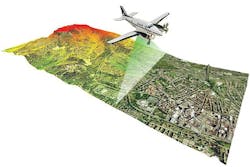Four companies to develop enabling technologies for tomorrow's electro-optical lidar sensor
Officials of the U.S. Defense Advanced Research Projects Agency (DARPA) in Arlington, Va., have announced four contracts over the past two weeks collectively worth $16.3 million for the Modular Optical Aperture Building Blocks (MOABB) project.
MOABB aims to develop enabling technologies for a small lightweight electro-optical sensor using free-space optical technology with ultra-low size, weight, and cost with much faster beam scanning speeds than are available today.
The project will develop technologies for an integrated photonic device that can generate, amplify, transmit, and receive free-space optical radiation over a wide angle. Researchers eventually would like to demonstrate this technology in a lidar sensor.
Companies involved in the DARPA MOABB project are Lockheed Martin Coherent Technologies in Louisville, Colo.; TREX Enterprises Corp. in San Diego; Analog Photonics LLC in Hingham, Mass.; and Teledyne Scientific & Imaging LLC in Thousand Oaks, Calif.
DARPA researchers want to build planar, millimeter-scale transmit/receive units with a high fill factor aperture, non-mechanical beam steering, and integrated amplification. Their goal is to tile the unit cells to assemble a large coherent higher-power aperture.
The program ultimately seeks to fabricate a coherent 10-centimeter transmit/receive array with distributed gain built with wafer-scale processing, and demonstrate the coherent array in a packaged lidar system capable of 3-D imaging from as far away as 100 meters.
DARPA awarded a $7.1 million contract to Lockheed Martin Coherent Technologies on 9 Aug.; a $4.2 million contract to TREX Enterprises on 4 Aug.; a $3 million contract to Analog Photonics on 3 Aug.; and a $2 million contract to Teledyne Scientific on 27 July.
All the contracts have options that could increase their value substantially. TREX Enterprises could earn as much as $23.6 million; Analog Photonics as much as $19.4 million; and Teledyne Scientific as much as $8.6 million.
Free-space optical systems have tremendous potential for sensing, illumination, and communications, DARPA scientists say. The micron-scale wavelength allows for 0.001-degree angular resolution and antenna gain of more than 100 decibels from a modest 10-centimeter aperture.
Related: Lidar, computer simulation blend in avionics to help helicopter pilots land safely in dust
The frequency in the hundreds of terahertz range and wide operating bandwidths enable high-speed data transmission and 3-D imaging with sub-millimeter range resolution. Optical beams also have wide windows of low atmospheric absorption for long-range propagation over terahertz of open bandwidth.
Applications for these features span the space from 3-D mapping, foliage penetrating lidar, navigation, and long-range communications.
While free-space optical systems offer compelling capabilities, they are too big, heavy, and expensive for many applications. Above a 10-centimeter aperture, their size and weight are dominated by the bulky lenses, mirrors, stabilized mechanical components, and large volume of empty space of the telescope or imaging system.
On the other hand, aperture smaller than 10 centimeters still require bulky mechanical gimbals to steer the telescope and the back-end optics like lasers and detectors.
Instead, DARPA scientists want to capitalize on recent developments in integrated photonics that offer the potential for high-speed, non-mechanical beam-steering. Researchers believe that efficient sources, detectors, amplifiers, and low-loss waveguides can be fabricated on one planar platform for high-power, large scale apertures.
The MOABB program has two technical areas: technologies for a tileable optical array element for operation in the short-wave infrared band; and a packaged lidar system that demonstrates the utility of this kind of technology.
The 21-month first phase of the MOABB program will address the modular transmit and receive unit cells. The second 18-month phase will develop the unit cell efficiency and fill-factor, and the 21-month third phase will develop 100-square-inch transmit and receive apertures.
For more information contact Lockheed Martin online at www.lockheedmartin.com; TREX Enterprises at www.trexenterprises.com; Analog Photonics at www.analogphotonics.com; Teledyne Scientific & Imaging at www.teledyne-si.com; or DARPA at www.darpa.mil.
Learn more: search the Aerospace & Defense Buyer's Guide for companies, new products, press releases, and videos
